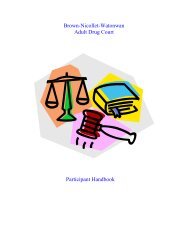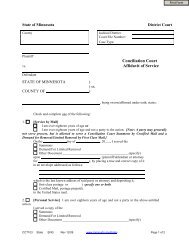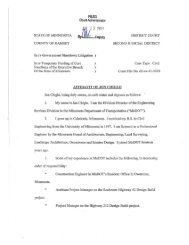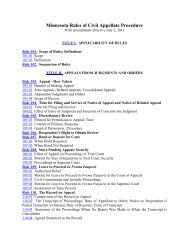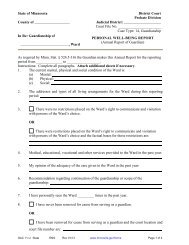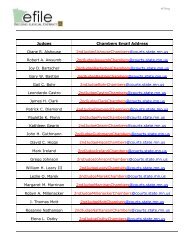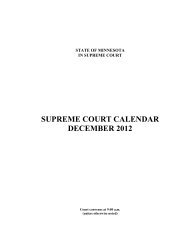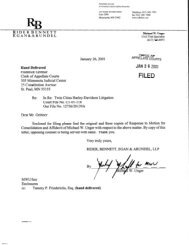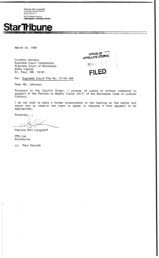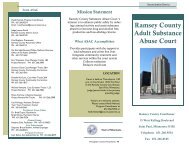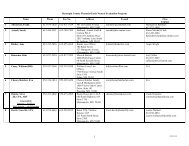MN Advisory Comm Exhibits 1-18 - Minnesota Judicial Branch
MN Advisory Comm Exhibits 1-18 - Minnesota Judicial Branch
MN Advisory Comm Exhibits 1-18 - Minnesota Judicial Branch
You also want an ePaper? Increase the reach of your titles
YUMPU automatically turns print PDFs into web optimized ePapers that Google loves.
Add an immense radio-television audience<br />
and the judicial process is impeded<br />
future. If so, the high’price will have an intrinsic value.<br />
FINDINcANlMpARmJuRY<br />
Telecasting a trial ‘can pose many problems if a new trial-<br />
becomes necessary. Whatwill be the source of an im-<br />
partial jury on.retrial if the tirst trial was made notori-<br />
ous before a wide public audience? Take, for example,<br />
the case ofRideau v. Louisiana [373 US; 723,83 S.Ct.<br />
1417 (1963)]. The defense filed a motion for a change of<br />
venue, saying that the defendant would be deprived of<br />
his constitutional rights if he was tried in Calcasieu<br />
Parish because, during a televised interview from the<br />
jail in which the defendant was interrogated by the<br />
sheriff, he confessed to the crimes with which he was<br />
charged. The motion was denied and the defendant was<br />
convicted of murder and sentenced to death-a judg-<br />
ment that was confirmed by the Louisiana Supreme<br />
Court. On certiorari, however, the U.S. Supreme Court<br />
reversed the decision, holding that due process of law<br />
required a trial before a jury from a community of peo-<br />
ple who had not seen or heard the televised interview.<br />
Now, as many states are reviewing their policies ad-<br />
mitting cameras in the courtroom, there is important<br />
empirical data supporting the stand against such a<br />
practice. The Bar Association of Greater Cleveland<br />
conducted a-study in early 1980 that surveyed the atti-<br />
tudes of judges, jurors, attorneys, and witnesses in-<br />
volved in either a major trial that received gavel to gavel<br />
television coverage or two other proceedings in which<br />
cameras appeared only episodically.<br />
The data indicate that the presence of television<br />
cameras in the courtrooms had a substantial delete-<br />
rious influence on a sizeable number of participants<br />
in the trial proceedings. Admittedly, litigants are not<br />
guaranteed a perfect trial, only a fair one, but can<br />
that requirement be met in an environment in which 50<br />
percent of the jurors, 30 percent of the witnesses, and<br />
54 percent of the lawyers are distracted? And isn’t that<br />
ill effect,compounded when 36 percent of the jurors, 43<br />
percent of the witnesses, and 54 percent of the lawyers<br />
are nervous in the presence of the cameras? And when<br />
those emotions are coupled with a fear of harm by 65<br />
percent of the jurors; 19 percent of the witnesses, and<br />
24 percent of the lawyers, what then becomes of a “fair<br />
trial”?<br />
A legal system that cannot equate due process with<br />
even the “reasonable possibility” of prejudice from the<br />
admission of illicitly acquired evidence can hardly be<br />
expected to tolerate prospects of unfairness of the<br />
dimension demonstrated in the Cleveland data. The<br />
Cleveland experiment should be run again and again<br />
across the country. If its results cannot be replicated,<br />
21<br />
th,en‘ it will be time to consider, and reconsider, the<br />
place cameras and microphones have in the courtroom.<br />
AWARNESSANDEFFECTSOFC,iMERAS<br />
INTHECOURTROOM<br />
~NJ~RORS,W~~NESSES,LA~RS,<br />
tiDJUDGES*<br />
(Reprinted with permission from the Cleveland Bar<br />
Journal, Vol. 7, No. 51, May 1980)<br />
AWARENESS OF CAMERAS IN THE COURTROOM<br />
Jurors 7- 88% yes<br />
Witnesses -<br />
Attorneys -<br />
Judges -<br />
74% yes<br />
100% yes<br />
100% yes<br />
PERCEFIION OF THE COURT AND THE<br />
EFFJSX ON ITS PROCEEDINGS<br />
What is the effect of cameras in the courtroom<br />
the dignity of the court?<br />
upon<br />
Jurors - 47% decreased, 44% no effect<br />
Witnesses - 21% decreased, 51% no effect<br />
Attorneys - 23% decreased, 77% no effect<br />
Judges - 33% decreased, 66% no effect<br />
Is the presence of cawteras in the courtroom disruptive<br />
of court procedures?<br />
Jurors - 50% yes (12% very disruptive)<br />
Witnesses - 32% yes<br />
Attorneys. - 61 YO yes<br />
Judges - 33% yes<br />
Do cameras in the courtroom<br />
informed on court procedures?<br />
make the public more<br />
Witnesses - 92% yes<br />
Attorneys - 92% yes<br />
Judges - 66% yes<br />
CONCENTRATION OF THE<br />
PARTICIPANTS IN THE TRIAL<br />
Did the cameras distract you?<br />
_’<br />
Jurors - 50% yes<br />
Witnesses - 30% yes<br />
Attorneys - 54% yes<br />
Judges - 33% yes<br />
Did the .presence of cameras in the courtroom<br />
you nervous?<br />
wtake .<br />
Jurors - 36% yes<br />
Witnesses - 43% yes<br />
Attorneys - 54% yes<br />
Judges - 100% no<br />
(Please turn to page 51)



